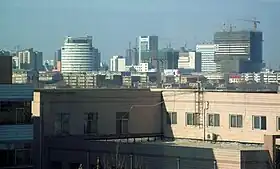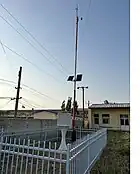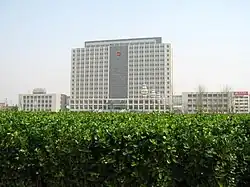Hengshui
衡水市 | |
|---|---|
    Clockwise from top: Fuyang Bridge, Hengshui Lake, Skyline of Hengshui, Hengshui High School | |
| Nickname(s): Peach City (桃城), Lake City (水市湖城) | |
.png.webp) Location of Hengshui City jurisdiction in Hebei | |
 Hengshui Location of the city centre in Hebei  Hengshui Hengshui (Northern China)  Hengshui Hengshui (China) | |
| Coordinates (Hengshui municipal government): 37°44′20″N 115°40′08″E / 37.739°N 115.669°E | |
| Country | People's Republic of China |
| Province | Hebei |
| Settled | 1265 |
| Established | May 31, 1996 |
| Municipal seat | Taocheng District |
| Area | |
| • Prefecture-level city | 8,836.95 km2 (3,411.97 sq mi) |
| • Urban | 401.40 km2 (154.98 sq mi) |
| • Districts[1] | 1,509.6 km2 (582.9 sq mi) |
| Population (2010 census) | |
| • Prefecture-level city | 4,340,773 |
| • Density | 490/km2 (1,300/sq mi) |
| • Urban | 856,705 |
| • Urban density | 2,100/km2 (5,500/sq mi) |
| • Districts[1] | 1,082,000 |
| Time zone | UTC+8 (China Standard) |
| ISO 3166 code | CN-HE-11 |
| License Plate Prefix | 冀T |
| Hengshui | |||||||
|---|---|---|---|---|---|---|---|
| Simplified Chinese | 衡水 | ||||||
| Literal meaning | "horizontal river" | ||||||
| |||||||
Hengshui (Chinese: 衡水) is a prefecture-level city in southern Hebei province, People's Republic of China, bordering Shandong to the southeast. At the 2010 census its population was 4,340,373 inhabitants whom 522,147 lived in the built-up (or metro) area made of Taocheng urban district.[2] It is on the Beijing–Kowloon railway.
Administrative divisions
| Map | ||||||
|---|---|---|---|---|---|---|
| # | Name | Hanzi | Hanyu Pinyin | Population (2010 census) | Area (km²) | Density (/km²) |
| 1 | Taocheng District | 桃城区 | Táochéng Qū | 522,147 | 602.5 | 867 |
| 2 | Jizhou District | 冀州区 | Jìzhōu Qū | 362,013 | 918 | 394 |
| 3 | Shenzhou City | 深州市 | Shēnzhōu Shì | 566,087 | 1,244 | 455 |
| 4 | Zaoqiang County | 枣强县 | Zǎoqiáng Xiàn | 391,469 | 903 | 437 |
| 5 | Wuyi County | 武邑县 | Wǔyì Xiàn | 315,693 | 830 | 380 |
| 6 | Wuqiang County | 武强县 | Wǔqiáng Xiàn | 214,549 | 442 | 485 |
| 7 | Raoyang County | 饶阳县 | Ráoyáng Xiàn | 280,498 | 573 | 490 |
| 8 | Anping County | 安平县 | Ānpíng Xiàn | 328,512 | 493 | 666 |
| 9 | Gucheng County | 故城县 | Gùchéng Xiàn | 487,025 | 941 | 518 |
| 10 | Jing County | 景县 | Jǐng Xiàn | 528,693 | 1,183 | 447 |
| 11 | Fucheng County | 阜城县 | Fùchéng Xiàn | 341,087 | 698 | 489 |
Education
Hengshui High School and Hengshui University[3] are located in Hengshui.
Sights
The Harrison International Peace Hospital is located in Hengshui. This comprehensive teaching and research hospital was named after Dr. Tillson Harrison, a martyr to the Chinese revolution. Dr. Harrison, a Canadian, died in 1947 while transporting medical equipment and supplies. Some of this equipment is on display in an exhibition room in the hospital. The hospital uses both traditional Chinese medicine and modern western diagnostic and therapeutic technology.
The city is renowned as the centre for inside painting, mainly of small snuff bottles. Zhang Rucai was born in Hebei Province and since 1972, he started to learn the art of inside painting. In April 1996, he was conferred the title Master of Chinese Folk Arts & Crafts by UNESCO. The city has a fascinating museum and exhibition of the art of the inside painter - many complex paintings done on the inside of small snuff bottles as well as special larger pieces of glassware.[4]
There is a Buddhist Temple on the outskirts of the city which is well worth a visit, as is the bridge in the old part of the city - one of the few remnants of the old town.
 Hengshui Old Town Bridge
Hengshui Old Town Bridge Hengshui Buddhist Temple
Hengshui Buddhist Temple
Geography and Climate
Hengshui has a cold semi-arid climate (BSk) using both the 18°C mean annual temperature isotherm and the 0°C mean lowest temperature isotherm of the coldest month (January) according to the Köppen climate classification, with hot, humid summers due to the East Asian Monsoon and brief, though very cold and dry winters, owing to the prevailing dry north-westerly winds that reflect the influence of the vast Siberian anticyclone.
Precipitation totals 496.9 mm annually with more than three quarters falling during the summer half. Extreme temperatures range from -20.6°C to 42.8°C for the 1981-2010 period. Relative humidity is highest in the summer and lowest in the spring, preceding the monsoonal period. Due to the very dry winter conditions, snowfall is not common, though occurs almost every year, usually in small amounts.

| Climate data for Hengshui (1991–2020 normals, extremes 1981–2010) | |||||||||||||
|---|---|---|---|---|---|---|---|---|---|---|---|---|---|
| Month | Jan | Feb | Mar | Apr | May | Jun | Jul | Aug | Sep | Oct | Nov | Dec | Year |
| Record high °C (°F) | 16.8 (62.2) |
23.3 (73.9) |
31.5 (88.7) |
34.6 (94.3) |
40.6 (105.1) |
40.6 (105.1) |
42.8 (109.0) |
38.3 (100.9) |
37.2 (99.0) |
32.2 (90.0) |
26.2 (79.2) |
18.6 (65.5) |
42.8 (109.0) |
| Mean daily maximum °C (°F) | 3.4 (38.1) |
7.7 (45.9) |
14.7 (58.5) |
21.9 (71.4) |
27.7 (81.9) |
32.3 (90.1) |
32.4 (90.3) |
30.7 (87.3) |
27.2 (81.0) |
21.0 (69.8) |
11.9 (53.4) |
4.9 (40.8) |
19.7 (67.4) |
| Daily mean °C (°F) | −2.3 (27.9) |
1.4 (34.5) |
8.1 (46.6) |
15.3 (59.5) |
21.4 (70.5) |
26.1 (79.0) |
27.5 (81.5) |
25.9 (78.6) |
21.2 (70.2) |
14.5 (58.1) |
6.0 (42.8) |
−0.5 (31.1) |
13.7 (56.7) |
| Mean daily minimum °C (°F) | −6.5 (20.3) |
−3.2 (26.2) |
2.8 (37.0) |
9.6 (49.3) |
15.5 (59.9) |
20.5 (68.9) |
23.2 (73.8) |
22.0 (71.6) |
16.6 (61.9) |
9.5 (49.1) |
1.6 (34.9) |
−4.3 (24.3) |
8.9 (48.1) |
| Record low °C (°F) | −18.3 (−0.9) |
−15.5 (4.1) |
−9.0 (15.8) |
−1.7 (28.9) |
4.5 (40.1) |
10.2 (50.4) |
16.8 (62.2) |
13.4 (56.1) |
6.7 (44.1) |
−2.2 (28.0) |
−16.4 (2.5) |
−20.6 (−5.1) |
−20.6 (−5.1) |
| Average precipitation mm (inches) | 1.6 (0.06) |
5.8 (0.23) |
7.8 (0.31) |
24.9 (0.98) |
38.2 (1.50) |
62.7 (2.47) |
151.3 (5.96) |
109.1 (4.30) |
41.0 (1.61) |
26.5 (1.04) |
14.9 (0.59) |
2.8 (0.11) |
486.6 (19.16) |
| Average precipitation days (≥ 0.1 mm) | 1.5 | 2.7 | 2.2 | 4.9 | 5.8 | 7.6 | 10.6 | 9.2 | 6.1 | 4.4 | 3.4 | 2.1 | 60.5 |
| Average snowy days | 2.8 | 3.3 | 1.1 | 0.2 | 0 | 0 | 0 | 0 | 0 | 0 | 1.2 | 2.5 | 11.1 |
| Average relative humidity (%) | 59 | 55 | 50 | 54 | 57 | 58 | 74 | 78 | 71 | 65 | 65 | 62 | 62 |
| Mean monthly sunshine hours | 157.4 | 171.4 | 225.4 | 240.5 | 267.0 | 238.2 | 200.5 | 208.5 | 204.0 | 197.1 | 161.2 | 152.7 | 2,423.9 |
| Percent possible sunshine | 51 | 56 | 60 | 61 | 61 | 54 | 45 | 50 | 55 | 57 | 54 | 52 | 55 |
| Source: China Meteorological Administration[5][6] | |||||||||||||

Air pollution
According to a survey made by "Global voices China" in February 2013, 7 cities in Hebei including Xingtai, Shijiazhuang, Baoding, Handan, Langfang, Hengshui and Tangshan, are among China's 10 most polluted cities.[7]
Religion
Hengshui is the seat of the Catholic Diocese of Hengshui.
References
- 1 2 3 4 Ministry of Housing and Urban-Rural Development, ed. (2019). China Urban Construction Statistical Yearbook 2017. Beijing: China Statistics Press. p. 46. Retrieved 11 January 2020.
- ↑ "China: Hébĕi (Prefectures, Cities, Districts and Counties) - Population Statistics, Charts and Map". Citypopulation.de. Retrieved 2 October 2017.
- ↑ "Hensghui High school". Archived from the original on 2007-08-03. Retrieved 2007-09-29.
- ↑ Archived 2011-02-07 at the Wayback Machine
- ↑ 中国气象数据网 – WeatherBk Data (in Simplified Chinese). China Meteorological Administration. Retrieved 26 August 2023.
- ↑ 中国气象数据网 (in Simplified Chinese). China Meteorological Administration. Retrieved 26 August 2023.
- ↑ Bildner, Eli (February 27, 2013). "Interactive Maps of China's Most–and Least–Polluted Places". Global Voices China. Archived from the original on 3 September 2014. Retrieved 1 September 2014.
